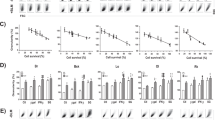Abstract
To investigate the factors influencing the bystander effect — a key element in the efficacy of suicide gene therapy against cancer — we compared the effect triggered by four extremely efficient gene/prodrug combinations, i.e., VZVtk/BVDU, the thymidine kinase of Varicella zoster virus associated with (E)-5-(2-bromovinyl)-2′-deoxyuridine; VZVtk/BVaraU, the same enzyme associated with (E)-5-(2-bromovinyl)-1-β-D-arabinofuranosyluracil; HSVtk/BVDU, the association of the Herpes simplex virus thymidine kinase with BVDU; and the classical HSVtk/GCV (ganciclovir) paradigm. The cells used, the human MDA-MB-435 breast cancer, and the rat 9L glioblastoma lines were equally sensitive in vitro to these four associations. In both cell types, the combinations involving pyrimidine analogues (BVDU, BVaraU) displayed a smaller bystander killing than the combination involving the purine analogue (GCV). In addition, the bystander effect induced by all the tk/prodrug systems was reduced in MDA-MB-435 cells in comparison to 9L cells; albeit, the viral kinases were produced at a higher level in the breast cancer cells. All systems induced apoptotic death in the two cell types, but the MDA-MB-435 cells, deprived of connexin 43, were noncommunicating in striking contrast with the 9L cells. That functional gap junctions have to be increased in order to improve the breast cancer cell response to suicide gene therapy was demonstrated by transducing the Cx43 gene: this modification enhanced the bystander effect associated in vitro with GCV treatment and, by itself, decreased the tumorigenicity of the untreated cells. However, the noncommunicating MDA-MB-435 cells triggered a significant bystander effect both in vitro and in vivo with the HSVtk/GCV system, showing that communication through gap junctions is not the only mechanism involved. Cancer Gene Therapy (2000) 7, 1456–1468
This is a preview of subscription content, access via your institution
Access options
Subscribe to this journal
Receive 12 print issues and online access
$259.00 per year
only $21.58 per issue
Buy this article
- Purchase on Springer Link
- Instant access to full article PDF
Prices may be subject to local taxes which are calculated during checkout
Similar content being viewed by others
Author information
Authors and Affiliations
Corresponding author
Rights and permissions
About this article
Cite this article
Grignet-Debrus, C., Cool, V., Baudson, N. et al. The role of cellular- and prodrug-associated factors in the bystander effect induced by the Varicella zoster and Herpes simplex viral thymidine kinases in suicide gene therapy. Cancer Gene Ther 7, 1456–1468 (2000). https://doi.org/10.1038/sj.cgt.7700250
Received:
Accepted:
Published:
Issue Date:
DOI: https://doi.org/10.1038/sj.cgt.7700250



